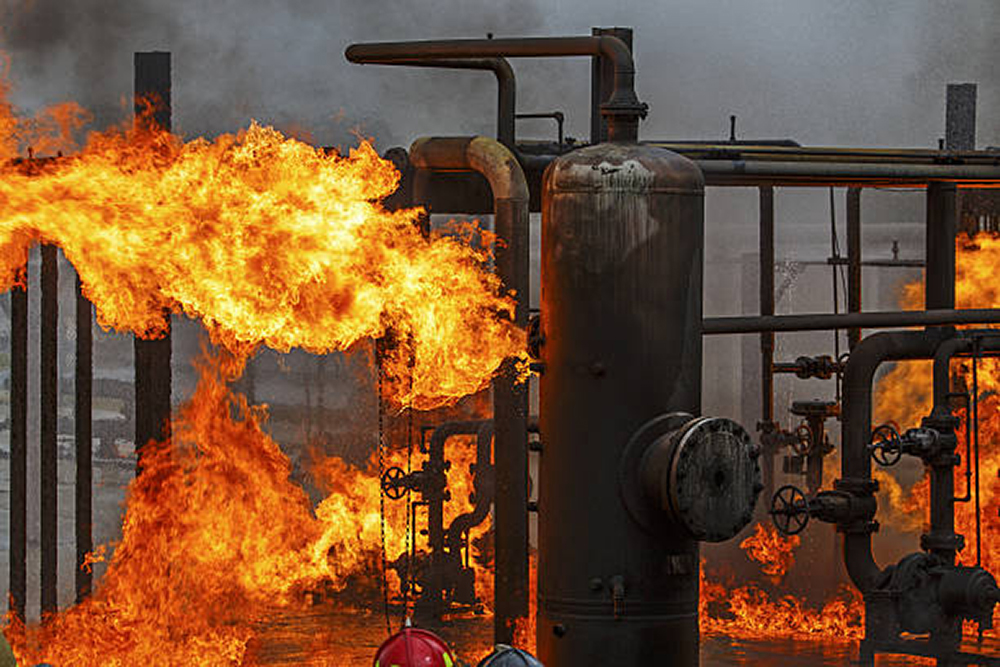The USW filed a lawsuit in federal court on Jan. 7, 2020, after the Environmental Protection Agency (EPA) heeded chemical and oil industry demands to remove key protections in the Chemical Disaster Rule that aim to prevent future chemical incidents and save the lives of workers and community members.
About 12,500 manufacturing plants use, store or manage highly hazardous chemicals that the rule covers.
“Eliminating these requirements will allow a profit-hungry industry to police itself while putting workers, first responders and the public at risk,” said USW International President Tom Conway. “The USW spent years advocating for the Chemical Disaster Rule. Thousands of our members signed petitions imploring the EPA not to gut it. Now, we’re going to court to protect our members and our communities.”
The USW’s lawsuit asks the U.S. Court of Appeals for the District of Columbia Circuit to implement the Chemical Disaster Rule as the EPA originally wrote it, before the current administration took office.
Why original rule is needed
EPA discovered that existing chemical regulations failed to prevent over 2,200 chemical fires, explosions, leaks and similar incidents during a 10-year period; 100 of these incidents caused injuries. It created the Chemical Disaster Rule to strengthen the prevention and preparedness requirements for chemical plants to avoid explosions and other catastrophic events.

The original rule forced companies to have better and more frequent coordination with first responders. This requirement grew out of the horrific April 2013 fire and explosion at a fertilizer storage and distribution facility in West, Texas, that killed 15 people, injured more than 160 and damaged or destroyed 150 buildings. One reason so many first responders died while fighting the fire at the plant was that they did not know there was ammonium nitrate present that could explode.
The local coordination provision of the original rule was preserved in the rollback, so the same amount of information will continue to be shared between the plants and first responders.
At least 180 million people in the U.S. live in the worst-case scenario zones for a chemical disaster, and at least one in three children attend school near a hazardous chemical facility. This is why the original rule supported community members’ access to information about the chemical hazards at the plants next door to them.
The USW called for the regulatory protections under the original Chemical Disaster Rule since a series of explosions, fires and leaks occurred in several of its sectors. In March 2005, a series of explosions and fires at BP’s Texas City, Texas, oil refinery killed 15 contractors and injured over 180 people. In the surrounding communities, some 43,000 residents had to shelter-in-place while first responders contained the disaster.
In April 2010, a fire and explosion at Tesoro’s Anacortes, Wash., refinery killed six USW members and a supervisor. The heat exchanger failed.
Two years later in August 2012, a corroding pipe broke and released a cloud of toxic fumes that ignited into a fireball at the Chevron refinery in Richmond, Calif. Luckily, no worker was killed, but the fireball spread a cloud of toxic smoke over the Richmond community, prompting 15,000 residents to seek medical treatment.
USW members’ quick thinking in June 2019 during a fire and explosions at Philadelphia Energy Solutions prevented hydrofluoric acid from escaping into the community and causing a disaster.
In November 2019, a pair of explosions and fires at the USW-represented TPC chemical plant in Port Neches, Texas, caused more than 50,000 people in East Texas to evacuate around Thanksgiving. Eight others were injured as the plumes of smoke from the fire spread 1,3-butadiene and other carcinogens into the air.
“These disasters are largely preventable,” said John Shinn, chair of the USW chemical sector. “The original Chemical Disaster Rule contained commonsense provisions that would save chemical and oil companies money by not having explosions, fires and releases.”
These incidents cost companies a lot of money in lawsuits, government fines, repairs, rebuilding and lost production and profits. For example, a 2016 Rand Corporation study on the cost-benefit analysis of proposed California oil and gas refinery regulations revealed that each major incident costs the affected refiner at least $220 million.
Interestingly, the EPA estimated the elimination of the original rule’s protections would save more than $87 million a year. In determining the “savings,” did the EPA estimate the cost of unnecessary deaths, injuries, property and plant damage, lost production and profits?
“Having a job in or living near a chemical plant or oil refinery should not cost you your life, livelihood or your health,” Shinn said.
Major protections gutted
Gone is the public’s ability to know what chemicals are stored at plants in their neighborhoods.
A public meeting is required only if there is an incident considered reportable under the risk management plan and it impacts the community. This includes known offsite deaths, injuries, evacuations, property or environmental damage or sheltering in place. Under the original rule, public meetings were required after any incident that had to be reported, including incidents that only impacted the plant site.
Companies no longer have to analyze the use of safer technology, procedures and materials that would eliminate risks.
If a release, explosion, fire or other incident occurs, there is no requirement an investigation include a root-cause analysis, along with a timeline for addressing recommendations and resolving problems.
Hazard reviews no longer are required to include findings from incident investigations. The same holds true for a process safety analysis, which also does not have to address potential failure scenarios.
Third-party compliance audits will not be required at facilities following a catastrophic event, or “near miss,” as was prescribed in the rule.
Even owners or operators do not have to keep process safety information up-to-date. Plus, the EPA removed from the rule’s text all mentions of a “near miss”—an incident that could have resulted in a catastrophic release. Companies can learn from near misses so disasters are averted.
